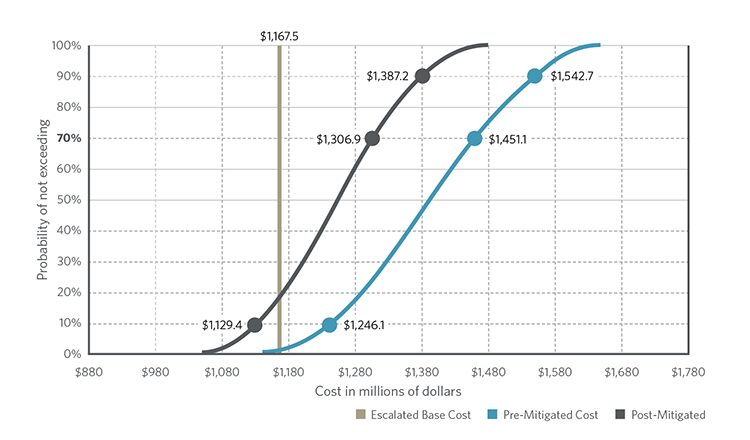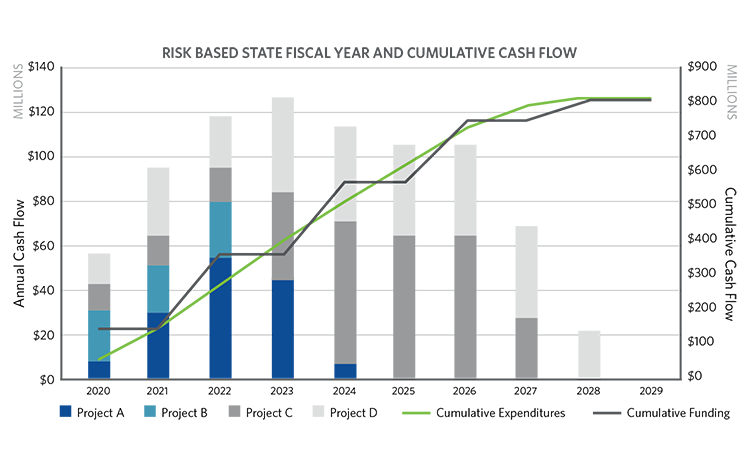
Experts Talk: Life Cycle Risk Management for Complex Infrastructure Programs with Jose Theiler
Experts Talk is an interview series with technical leaders from across our transportation program.
How Regular Risk Analysis and Value Engineering Efforts Can Strengthen Team Culture and Keep Transportation Programs on Budget and Schedule
Managing risk is like chocolate, Jose Theiler likes to say. Try it for the first time and you’ll wonder where it’s been all your life. As transportation programs continue to grow costlier and more complex, understanding what could affect a program and how is more important than ever to successful delivery. A robust risk management process, begun early and continued throughout a program, provides that understanding, keeping owners and teams on track and in a better position to meet schedules, budgets and stakeholder expectations.
Jose Theiler is our East region value engineering and risk management manager with four decades of experience leading teams to increase project and program value and performance. He has extensive experience on large and complex transportation projects and processes. Prior to joining us in 2015, Theiler co-led the development of the Florida Department of Transportation’s risk management program. In this interview he explains how a risk management approach benefits large infrastructure programs from initiation through delivery and how it can lead to larger positive culture change at agencies.
Q. Why is a risk management life cycle approach important on large infrastructure programs today?
A. Major programs have a huge number of unknowns and uncertainty. Managing risk reduces and controls the uncertainty. Ongoing risk assessment throughout the program or project life cycle helps owners evaluate new or potential impacts and make informed decisions on how to respond.
Many large projects and programs start with an expected cost and schedule, but as the program develops over years, those numbers evolve as more information is learned. Taking a life cycle approach is essential to effectively managing risks throughout planning, design and construction and produces more reliable cost and schedule forecasts with a high degree of accuracy and confidence. This allows client managers and executives to make informed decisions based upon real-time information, not guesses, which improves long-term planning as well as public and political acceptance.
Q. Describe your risk management process — how does it begin and who is involved?
A. Managing risk begins with setting a base cost and schedule for a program. These are derived by working with independent subject matter experts and estimators. A project or program’s components are examined in depth, looking at unit prices, quantities, labour costs and more. The purpose of this review is to remove contingencies, assign ranges to the estimates, and ensure that the estimates account for all possible elements of the project. What’s left is an unbiased assessment of the known costs, excluding contingencies, market conditions or inflationary factors.
Next is a workshop that brings together all the disciplines that will participate in the infrastructure program or project. We have trained engineer facilitators at HDR, many of whom are also Certified Value Specialists, who plan and lead the workshops. This collaborative process brings together internal and external stakeholders and subject matter experts to brainstorm and identify risks together, including threats or opportunities. The two most expensive risks by far are delays and changing market conditions. It’s also important to note that some risks are opportunities that can be exploited to benefit a program, rather than threats. For example, workshop participants may have identified the potential to avoid purchasing right of way. This could save a program millions of dollars, but the risk needs to be properly managed to realize that opportunity.
Those risks are then prioritized, their impacts are quantified, and consensus is formed around the appropriate response.
Instead of applying a broad set of assumptions and standard factors for unknowns, such as a fixed contingency amount, the risk-based method identifies and quantifies project event risks in terms of the probability of occurrence, and the range of impacts to cost and schedule.
For example, participants may determine that a delay in the National Environmental Policy Act process is 33% likely to happen, and if it occurs would cost an extra $1 million to $3 million and delay the project 6 to 18 months.

At the end, all these risks are put into a complex modelling system by statisticians and economists, who analyze the probability of each risk, how they would affect each other and the probable impact of each. This Monte Carlo modelling involves tens of thousands of iterations and produces a probability distribution of outcomes, allowing program leaders to say they’re 70% confident — or 80%, or another number depending on owners’ aversion to risk — that costs will not exceed a certain amount. It can also show projected differences in cost based on responses to identified risks.

These workshops can be scaled to match each program or project. A large multi-billion-dollar program may require an intensive multi-day workshop that matches the complexity of the program it is analyzing. A $10 million project would also benefit from risk management approaches but might only need a half-day workshop.
Q. How does the risk management life cycle approach continue through delivery?
A. Once the team has identified and quantified risks, they need to respond to them. There are four options: Accept it and set aside a contingency, transfer it to another responsible party such as a contractor, mitigate it or avoid it.
Some projects may benefit from utilizing value engineering to assist in responding to risks. Our workshop facilitators are usually also Certified Value Specialists, which means solutions can be developed from the beginning, almost as soon as risks are identified.
The benefits of using a risk-based approach continue through procurement and beyond. When the results of a cost-risk assessment are finalized, a risk management plan is started, and the information is used by procurement leaders in the legal and technical teams throughout the procurement process. As contract documents are drafted, the information in the risk management plan is referenced constantly so that the language in the contract document includes technical provisions that incorporate identified risk strategies.
Because risks are also ranked by relative severity, program leaders can use a management plan to prioritize their focus on risks that have the largest impacts on the project. Every risk will have a management strategy, but teams with limited resources will know where to focus their energy.
As program delivery progresses, the risk management plan continues to be updated, with risks removed or added. The risk assessment process is repeated and updated on a regular basis. Sometimes the updates are quicker meetings to ensure everything is still on track. Sometimes they are just as intense as the original one. For example, on projects over $500 million that are under federal oversight, this risk assessment process must be repeated at least every year and whenever a major change is made in scope.
These updates allow a team to develop accurate forecasts of indicative cash flows and the costs to complete a program. They also allow program leaders to analyze contingency, or risk reserve, in a comprehensive manner so that it is not released too early or kept hostage for too long. Instead of holding onto an extra 10% or 20% of budget just in case something comes up, risk managers will know how much risk still exists and when they can release these funds early to complete other projects.
Q. How does risk management benefit a complex multi-project program differently than one large infrastructure project?
A. Every project or program can benefit from proper risk management. But applying risk management strategies on a program offers another layer of value. Building a risk profile for each project in a program shows how each project’s risk contributes to the risk of an entire program and can offer insights into project prioritization and how to mitigate the risk impacts on other projects within a program.
For cash flow reasons, a major program is often split into smaller projects. A risk management approach can help determine the best method for sequencing those projects. This strategy can explore the cumulative effect of different sequencing options, to determine which scenario makes the most sense.

The improved cost certainty can also help a program determine which projects to pursue. Perhaps a region has $750 million of projects on its wish list, but only $500 million to spend. The improved schedule and budget forecasting of a risk management approach can help an agency understand which projects have the best chance of fulfilling as many of their goals as possible.
Q. How can risk management positively impact an organization’s culture?
A. When you look at risk from a programmatic perspective, you start leading a culture change as well. Agencies can learn not only how to manage their contingencies, but also how to create an organizational culture that proactively manages risk and fixes issues before they become major problems.
On one major program I worked on, our risk assessment determined that delays in utility relocation were likely to extend for more than a year and raise the project cost by more than $100 million. Rather than accept the risk, the agency created new processes and procedures to fix the underlying problem. Those changes eliminated the risk for that particular program, but also eliminated the same potential problem for other projects at the agency.
On another project, an agency discovered it may not have enough environmental credits to compensate for environmental impacts, which could cause a multi-year delay. To avoid the issue in the future, the agency not only began buying more credits but also created new projects that would increase their environmental credits. These examples show the impact that an agency-wide culture of risk management can make, proactively improving processes and procedures.
Inspiration & Advice
Q. How did your career lead you to risk management?
A. Throughout my career, I’ve always asked why, including trying to determine why things don’t happen as we want and how to avoid that in the future. That led me to trying to find a method to answer that, which prompted me to learn more about value engineering. The continued search for better processes and solutions soon led me to risk management, and while with Florida DOT, they became an early adopter of Federal Highway Administration’s risk management process. I co-led the development of the agency’s program and helped to instill a culture of risk management.
Q. What advice do you have for others interested in this specialty?
A. We’re all already managers of risk. Every decision we make is done for a reason, whether we realize it or not. You start managing risk from the moment you wake up in the morning until you fall asleep at night, in a small or large way. For engineers and program managers, risk management and value engineering are two essential tools to succeed in delivering projects within budget and just in time. Don’t be afraid to ask why and challenge the status-quo and begin looking for better ways of completing work.
Each Experts Talk interview illuminates a different aspect of transportation infrastructure planning, design and delivery. Check back regularly to discover new insights from the specialized experts and thought leaders behind our award-winning, full service consulting practice.

